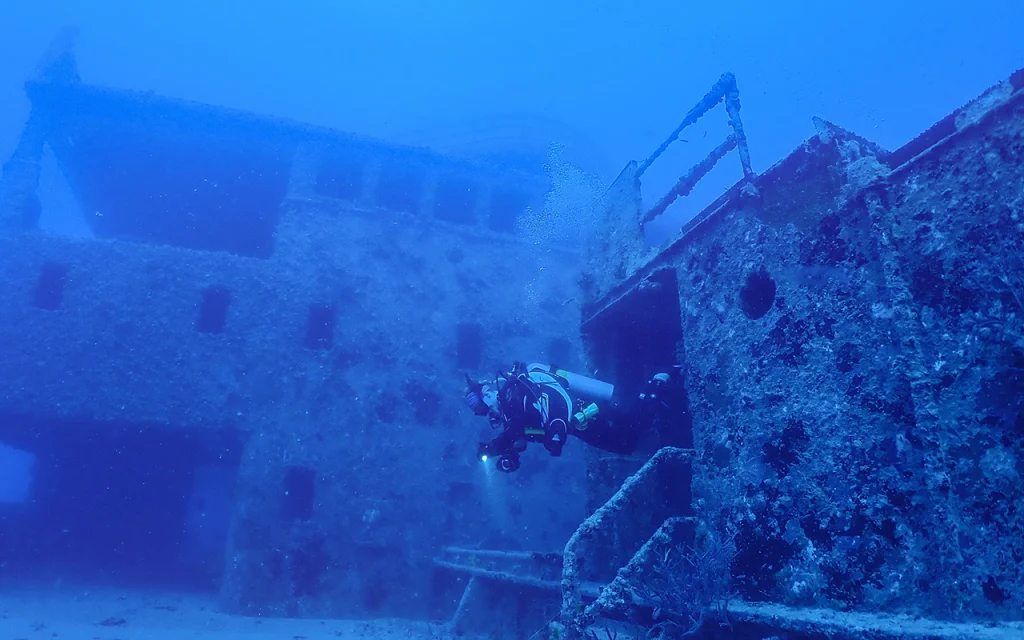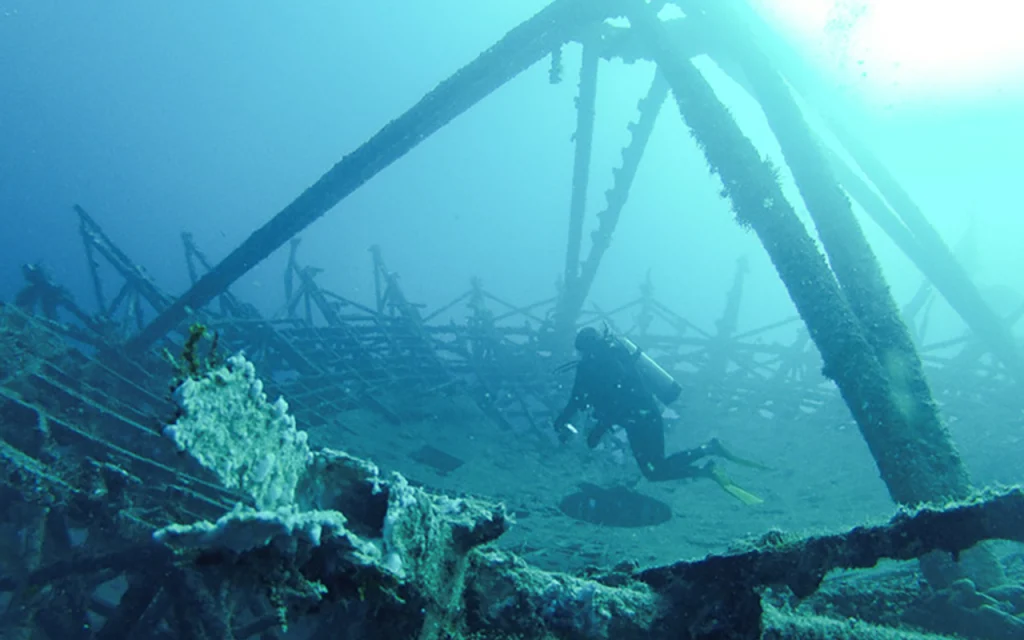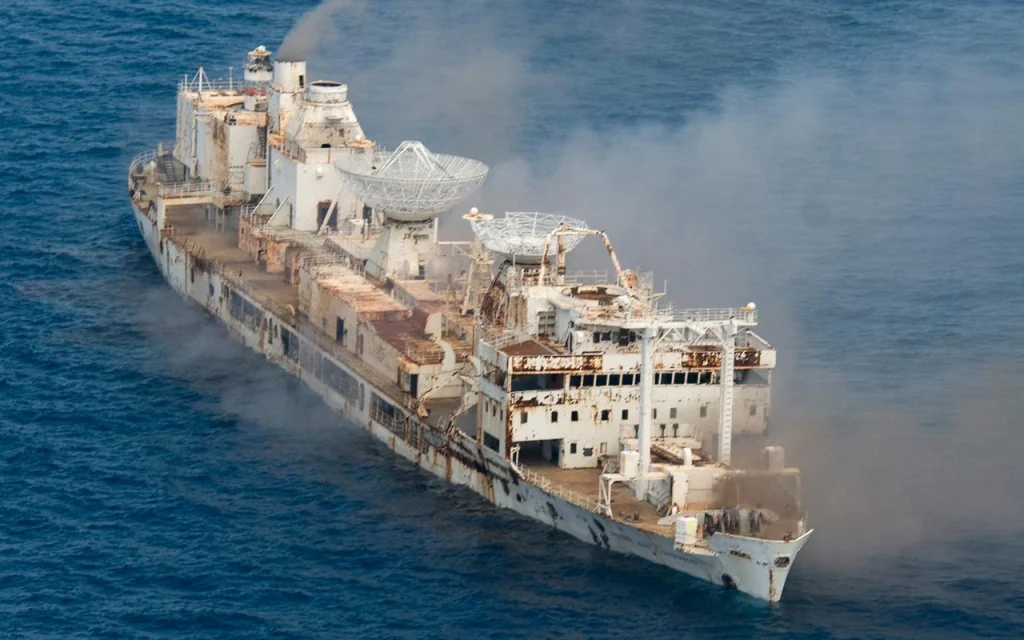Table of Contents

The Vandenberg’s transformation from a military vessel to a vibrant underwater ecosystem exemplifies the potential for artificial reefs to enhance marine habitats and promote recreational diving.
Article at a Glance
- Location: 7 miles south of Key West, Florida (24° 27′ 46.9″ N, 81° 44′ 22.3″ W)
- Depth: 140 feet (43 meters) to the bottom, main deck at about 100 feet
- History: Former military vessel, served in WWII and Cold War, sunk as artificial reef in 2009
- Size: 523 feet long, second-largest intentionally sunk artificial reef in the world
- Marine Life: Home to barracuda, goliath grouper, colorful reef fish, and growing coral colonies
- Dive Experience: Suitable for various skill levels, features unique structures like radar dishes and the bridge
- Safety: Guided dives available, strong currents possible, proper training and equipment recommended
USNS Vandenberg Wreck Location Coordinates and Depth
Depth
The wreck lies at a depth of 140 feet (approximately 43 meters) in the Florida Keys National Marine Sanctuary.
Location Coordinates
The wreck of the USNS Vandenberg is located approximately seven miles south of Key West, Florida. The specific coordinates are:
- Latitude: 24° 27′ 46.9″ N
- Longitude: 81° 44′ 22.3″ W
What to Scuba Divers Say About This Wreck
- Accessibility and Depth: The Vandenberg is considered accessible for divers of various certification levels, although it is important for less experienced divers to be mindful of the depth (around 100 feet or 30 meters) and the potential for strong currents. Many recommend having some prior diving experience before attempting this wreck dive, especially for those who are new to diving.
- Current Conditions: The current can vary significantly, impacting the dive experience. Some divers reported fantastic conditions with minimal current, while others faced challenging currents that made the dive more strenuous. Using buoy lines for descent is often recommended to manage the current effectively.
- Visibility and Marine Life: Visibility is generally good, allowing divers to enjoy the wreck and its surroundings. The Vandenberg is home to various marine life, including barracudas and nurse sharks, which adds to the excitement of the dive.
- Overall Experience: Many divers describe the Vandenberg as an “awesome dive” with a fascinating wreck to explore. However, some advise that new divers may want to gain more experience on shallower reefs before attempting this deeper wreck dive to ensure they can manage their air consumption and enjoy their time underwater.
- Diving Packages: Several dive operators offer guided dives to the Vandenberg, ensuring that divers have support and can explore the wreck safely. These trips are highly rated, emphasizing the professionalism of the dive teams and the overall experience.
What Kind of Marine Life Can Be Found on The Wreck
- Large Fish: The wreck is home to significant populations of large fish, including goliath grouper and barracuda. These species are often seen swimming around the structure, making for exciting encounters.
- Colorful Reef Fish: Divers frequently spot various colorful reef fish, such as parrotfish, wrasses, and damselfish. These species add vibrant colors to the underwater scenery.
- Surgeonfish: Known for their sharp spines, surgeonfish are also common around the wreck, contributing to the biodiversity of the site.
- Predatory Fish: The deeper parts of the wreck may reveal more elusive species, including Nassau grouper, moray eels, and even sharks.
- Invertebrates: The wreck supports a variety of invertebrates, such as octopus, conch, and rock lobster, enhancing the ecological complexity of the site.
- Coral Growth: Over time, corals have begun to take hold on the surfaces of the ship, providing habitat for smaller marine organisms and contributing to the overall health of the reef ecosystem.
Key Information
| Category | Details |
|---|---|
| Name | USNS Vandenberg |
| Location | 7 miles south of Key West, Florida |
| Coordinates | Latitude: 24° 27′ 46.9″ N, Longitude: 81° 44′ 22.3″ W |
| Depth | Ranges from 40 feet to 140 feet |
| Size | 523 feet long, 100 feet tall |
| History | – Commissioned as U.S. Army Transport Gen. Harry Taylor in 1944 |
| – Served as a troop transport during WWII | |
| – Reacquired by the Navy in 1950, renamed Gen. Hoyt S. Vandenberg in 1961 | |
| – Used for missile and space tracking during the Cold War | |
| – Decommissioned in 1983, used in the film “Virus” in 1996 | |
| Sinking Date | May 27, 2009 |
| Purpose | Artificial reef |
| Marine Life | – Goliath grouper, barracuda, parrotfish, wrasses, damselfish, surgeonfish |
| – Nassau grouper, moray eels, sharks, octopus, conch, rock lobster | |
| Diving Experience | – Suitable for various certification levels |
| – Strong currents may be present, guided dives recommended | |
| – Pre-dive briefings and safety protocols in place | |
| Notable Features | – Radar dishes, bridge and wheelhouse, weather balloon hangar, interior compartments |
| – Covered in corals and inhabited by diverse marine life | |
| Dive Operators | – Captain’s Corner Dive Center, Capt. Hook’s Dive Key West, Finz Dive Center and Tackle Shop |
| – Lost Reef Adventures, Southpoint Divers, Key West Dive Center |
What Makes USNS Vandenberg a Unique Diving Experience
- Size and Structure: At 523 feet long and 100 feet tall, the Vandenberg is the second-largest intentionally sunk artificial reef in the world. Its massive size provides a variety of diveable structures, ranging from 40 to 140 feet deep, allowing divers of different skill levels to explore various parts of the wreck.
- Accessibility: The wreck is located just seven miles from Key West, making it easily accessible for divers. The relatively shallow depths of the main deck (around 100 feet) allow for a more manageable dive experience, though divers should be aware of the strong currents that can occur.
- Diverse Marine Life: Since its sinking in 2009, the Vandenberg has become home to a rich array of marine life, including large fish like barracuda and goliath grouper, as well as colorful reef fish and invertebrates. This biodiversity enhances the underwater experience, making each dive unique.
- Historical Significance: The Vandenberg has a storied history, having served as a troop transport and missile-tracking ship during the Cold War. This historical context adds an intriguing layer to the dive, as divers can explore the remnants of its past, including radar dishes and other features.
- Variety of Dive Experiences: The wreck offers opportunities for both novice and experienced divers. Less experienced divers can explore the upper structures and enjoy the vibrant marine life, while advanced divers can penetrate deeper into the wreck, navigating its interior spaces.
- Unique Features: The wreck includes notable structures such as the giant radar dishes, the bridge, and the aft balloon hangar. These features provide excellent photo opportunities and points of interest for divers.

What is The Full History of This Wreck
Early Years and Military Service
- Commissioning and World War II: The vessel was commissioned as the U.S. Army Transport Gen. Harry Taylor on May 8, 1944. It served primarily as a troop transport during World War II, facilitating the movement of soldiers and supplies.
- Post-War Transition: After being decommissioned on June 13, 1946, the ship was reacquired by the Navy in 1950 for use by the Military Sea Transportation Service.
- Transfer to the Air Force: On July 15, 1961, the ship was transferred to the U.S. Air Force and renamed the Gen. Hoyt S. Vandenberg. It was then designated as an Advanced Range Instrumentation Ship (ARIS), tasked with tracking missiles and spacecraft launches during the Cold War.
Role in Space Exploration
- Missile and Space Tracking: From 1962 to 1983, the Vandenberg played a crucial role in monitoring missile tests and tracking space missions, including those of the Mercury, Gemini, and Apollo programs. It was equipped with advanced radar and telemetry systems to support these operations.
Retirement and Transition to Artificial Reef
- Decommissioning: The Vandenberg was retired in 1983 and moved to the James River Reserve Fleet in Virginia for storage.
- Film Appearance: In September 1996, the ship was leased to Universal Studios for the filming of the science fiction movie “Virus,” where it was depicted as a derelict vessel.
- Conversion to Artificial Reef: The idea to sink the Vandenberg as an artificial reef emerged in the late 1990s. Joe Weatherby, a local advocate, identified the ship as an ideal candidate for this purpose. After extensive planning and environmental assessments, the ship was transferred to the State of Florida for reefing in January 2007.
Sinking and Current Status
- Preparation and Sinking: Prior to its sinking, the Vandenberg underwent significant cleanup to remove hazardous materials, including asbestos and various pollutants. On May 27, 2009, the ship was scuttled approximately seven miles south of Key West, Florida, at 10:24 AM, becoming the second-largest artificial reef in the world.
- Current Dive Site: Today, the Vandenberg rests upright at a depth of about 140 feet (approximately 43 meters) and has become a popular destination for divers. The wreck has quickly transformed into a thriving artificial reef, attracting diverse marine life and providing an exciting diving experience for enthusiasts.

What Historical Features Can Still Be Identified on Wreck
1. Radar Dishes and Antennas
The ship was equipped with large radar dishes and antennas used for tracking missiles and spacecraft during its operational years. Although some of these structures have deteriorated over time, remnants can still be seen, providing insight into the ship’s technological capabilities during the Cold War.
2. Bridge and Wheelhouse
The bridge area is a significant feature that divers often explore. It is spacious and accessible, allowing divers to swim through and appreciate the layout of the command center. A notable feature within the bridge is a POW flag, which adds a poignant touch to the dive experience.
3. Weather Balloon Hangar
The hangar, used for weather balloons during the ship’s service, is another area of interest. This compartment showcases the ship’s role in scientific endeavors and tracking operations.
4. Interior Compartments
Divers can access various compartments within the wreck, which were part of the ship’s operational design. These areas provide a glimpse into the living and working conditions of the crew during its time in service.
5. Hull Structure
The Vandenberg’s hull stretches approximately 523 feet long, making it an impressive sight underwater. The structure provides numerous swim-through opportunities and is home to vibrant marine life, enhancing the diving experience.
6. Historical Significance
Beyond physical structures, the ship’s history as a troop transport during World War II and as a missile-tracking vessel during the Cold War adds a layer of historical context that divers find fascinating. The ship’s legacy is often discussed among divers, enriching their exploration of the wreck.
7. Marine Growth
Since its sinking in 2009, the Vandenberg has become a thriving artificial reef, covered in corals and inhabited by diverse marine life. This ecological transformation is a testament to the ship’s purpose as an artificial reef and provides divers with a unique blend of history and marine biology.
What Safety Measures Are in Place for Divers Visiting USNS Vandenberg
- Guided Dives: Many dive operators offer guided dives led by experienced dive masters. This is particularly important due to the wreck’s depth and potential strong currents, ensuring that divers have knowledgeable support throughout the dive.
- Buddy System: Divers are encouraged to use the buddy system, which enhances safety by ensuring that no diver is alone underwater. This practice allows divers to assist each other in case of emergencies or disorientation.
- Pre-Dive Briefings: Before diving, operators typically conduct thorough briefings that cover the dive plan, safety protocols, and potential hazards associated with the wreck. This includes information on the currents, visibility, and specific areas of interest on the wreck.
- Emergency Equipment: Divers are advised to carry safety equipment, such as dive knives, to address potential entanglements. Additionally, dive operators are equipped with emergency oxygen supplies and first aid kits on board their vessels.
- Depth Awareness: The Vandenberg sits at varying depths, with its main deck around 100 feet deep and the hull reaching down to 140 feet. Divers are reminded to monitor their depth and air supply closely, especially when exploring deeper sections of the wreck.
- Current Awareness: Divers are cautioned about the possibility of strong currents in the area. Operators often provide guidance on how to manage these conditions effectively, including the use of buoy lines for descent and ascent.
- Experience Recommendations: While the Vandenberg is accessible to divers with varying skill levels, it is recommended that those who wish to penetrate the wreck or explore deeper areas have advanced training and experience in wreck diving.
Dive Shops That Prove Diving Trips to This Shipwreck
Captain’s Corner Dive CenterRating: 4.9
Reviews: 315
Address: 125 Ann St, Key West, FL 33040
Website: Captain’s Corner
Capt. Hook’s Dive Key WestRating: 4.3
Reviews: 182
Address: 3128 N Roosevelt Blvd, Key West, FL 33040
Website: Capt. Hook’s Dive
Finz Dive Center and Tackle ShopRating: 4.9
Reviews: 205
Address: 6021 Peninsular Ave, Key West, FL 33040
Website: Finz Dive Center
Lost Reef AdventuresRating: 4.7
Reviews: 250
Address: 261 Margaret St #6639, Key West, FL 33040
Website: Lost Reef Adventures
Southpoint DiversRating: 4.5
Reviews: 197
Address: 606 Front St, Key West, FL 33040
Website: Southpoint Divers
Key West Dive CenterRating: 4.3
Reviews: 42
Website: Key West Dive Center





